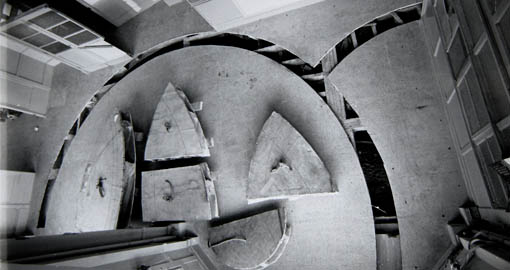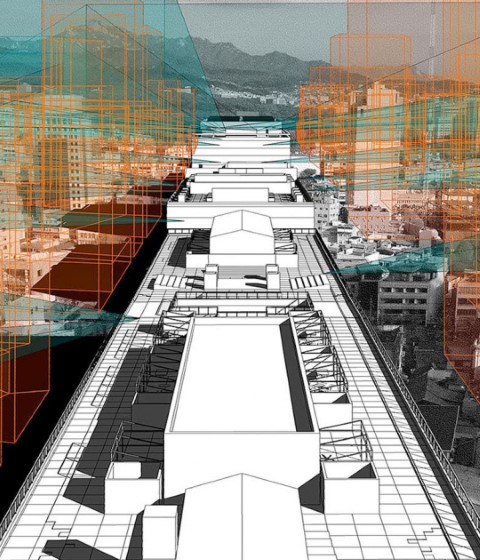MACBA, the Museu d’Art Contemporani de Barcelona, presents My Summer 77 with Gordon Matta-Clark (1977-2012), a film never before seen, on the creation in Antwerp of Office Baroque (1978), one of the artist’s last building cuts. Promoted by Harold Berg, the film was made and produced by Cherica Convents.
Invited by the Internationaal Cultureel Centrum (ICC) of Antwerp (Belgium), Gordon Matta-Clark (New York, 1943-1978) spent the period from May to August 1977 working on Office Baroque, one of the few building cuts that the artist felt should be conserved. However, despite all efforts to this end, on 3 June 1980 Antwerp City Council executed the order to demolish the building. All that remains from that legendary intervention are a few of the artist’s notes, vestiges from the building kept in different collections and museums, photographic documents and a film made by Cherica Convents.
Thirty-five years later, Cherica Convents has recovered unseen sequences from that film shoot. The footage that now sees the light shows a thoughtful and talkative Gordon Matta-Clark who is, nonetheless, immersed in brutally hard, physical work. The camera captures him as if it were filming a dance featuring an architectural speculation, translated into what the artist himself calls an atmosphere of “dust, ruins, depravation and spatial complexity.” This 30-minute film provides an outstanding resource for indepth study of one of the most influential 20th-century artists.
Harold Berg donated My Summer 77 with Gordon Matta-Clark to the MACBA Collection together with another film, Office Baroque, by Roger Steylaerts and Cherica Convents. These documents are added to Portfolio Office Baroque, which the collector himself built up, and will be on display in the MACBA exhibition rooms until October 21. The new acquisitions to the MACBA Collection make the Museum a reference for understanding the last period in Gordon Matta-Clark’s production. Moreover, the additions also furthers MACBA’s commitment to increasing its holdings of heritage relating to artistic practices from the 1970s characterised by their critical stance.

Gordon Matta-Clark.
Works by Gordon Matta-Clark at MACBA
Harold Berg acquired the Florent Bex photographic archive to add it to his LATA Collection (a name that alludes to its Latin American origins), depositing these works in the form of a permanent loan to the MACBA Foundation on 23 May de 2011. The holding comprises 46 works: 44 vintage black-and-white photographs on paper (25 °— 20 cm); 1 black-and-white negative; and 1 manipulated slide. The Bex Archive contains a series of photographs by Gordon Matta-Clark of the ephemeral interventions he made in buildings, using cuts and extractions from floors, walls and other structural elements. Thanks to the acquisition of these 46 works from the LATA Collection, added to the latest donations, MACBA holdings include a total of 65 pieces by Matta-Clark (the Museum already possessed 17 works – 13 videos, 2 photographs and 2 photocollages). Consequently, MACBA is one of the European museums with the largest number of works by this artist, along with the Generali Foundation (Vienna), the Georges Pompidou (Paris) and the Reina Sofía (Madrid).




















![Matta-Clark, Gordon Office Baroque, 4th Floor [Documentació de l'acció "Office Baroque" realitzada el 1977 a Anvers, Bèlgica] 1977 Fotografia a les sals de plata 25,3 x 20,3 cm Col·lecció MACBA. Fundació Museu d'Art Contemporani de Barcelona. Dipòsit Col·lecció LATA Matta-Clark, Gordon Office Baroque, 4th Floor [Documentació de l'acció "Office Baroque" realitzada el 1977 a Anvers, Bèlgica] 1977 Fotografia a les sals de plata 25,3 x 20,3 cm Col·lecció MACBA. Fundació Museu d'Art Contemporani de Barcelona. Dipòsit Col·lecció LATA](/sites/default/files/styles/mopis_home_news_category_slider_desktop/public/lead-images/ml4147_mg_8986.jpg?h=8b2a012f&itok=v0X8-j5Z)
![Gordon Matta-Clark Office Baroque [Documentation of "Office Baroque" 1977 in Anvers, Belgium] Col·lecció MACBA. Fundació MACBA. Col·lecció LATA © Estate of Gordon Matta Clark, VEGAP, Barcelona, 2012. Photography: Vanessa Miralles Gordon Matta-Clark Office Baroque [Documentation of "Office Baroque" 1977 in Anvers, Belgium] Col·lecció MACBA. Fundació MACBA. Col·lecció LATA © Estate of Gordon Matta Clark, VEGAP, Barcelona, 2012. Photography: Vanessa Miralles](/sites/default/files/styles/mopis_home_news_category_slider_desktop/public/lead-images/ml_mattaclark_01_1024_p.jpg?h=3b4e7bc7&itok=VLk9w6-z)






